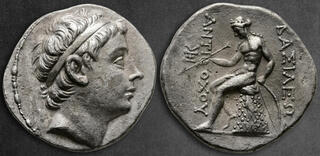Lot description:
Seleukid Kingdom. Antioch on the Orontes. Antiochos III Megas 222-187 BC.
Tetradrachm AR
30 mm, 16,13 g
Diademed head right / BAΣIΛEΩ[Σ] ANT-IOXOY, Apollo Delphios, nude but for chlamys draped from his waist, wearing laurel wreath and seated on omphalos to left, testing arrow with his right hand and resting his left on a bow leaning against the omphalos behind him, monogram to outer left.
Nearly Extremely Fine
SC 1042.1.
Antiochus III Megas, widely known as Antiochus III the Great, was a significant figure in the Hellenistic period, reigning over the vast Seleucid Empire from 222 BC to 187 BC. His rule is characterized by ambitious military campaigns and strategic diplomacy, leaving a lasting impact on the ancient world.
Antiochus III ascended the Seleucid throne during a challenging era, with the empire's influence waning. Determined to restore its former glory, he embarked on an impressive series of military expeditions. One of his most notable achievements was the successful invasion of Egypt, which led to the recovery of territories in Asia Minor, the Levant, and even parts of Greece.
However, his ambitions weren't without opposition. The Fourth Syrian War against Egypt,
though initially victorious, ultimately saw a defeat at the Battle of Raphia. Furthermore, his efforts to expand into Asia Minor brought him into direct conflict with the formidable Roman Republic.
Antiochus III's conflict with Rome resulted in the Peace of Apamea in 188 BC, a treaty that forced him to surrender territories and curtailed his territorial aspirations. Despite the setbacks, his reign left a significant mark on the Seleucid Empire's history, symbolizing a brief resurgence of power.
Tragically, Antiochus III's life came to an untimely end when he was assassinated in 187 BC
during an eastern campaign. His legacy is one of both ambition and limitation, a ruler whose
grand designs clashed with the growing might of Rome, shaping the destiny of the Seleucid
Empire and the broader course of history in the Hellenistic era.
Starting price: 200 EUR |  |